Championing Peter Brannan
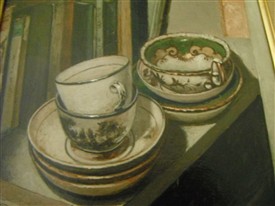
Cups & Saucers (1968)
Newark Town Hall Museum Collection, kind permission of the artist's estate
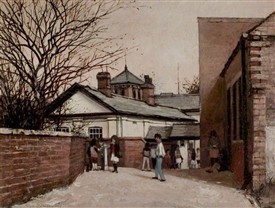
Mount School (1983)
Newark Town Hall Museum Collection, kind permission of the artist's estate
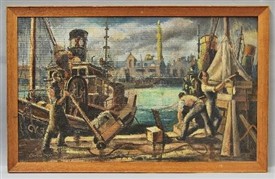
Grimsby Docks (1949)
Newark Town Hall Museum Collection, kind permission of the artist's estate
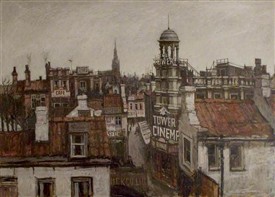
Aerial view of Newark (1968)
Newark Town Hall Museum Collection, kind permission of the artist's estate
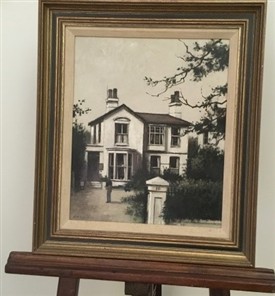
The Dentists, Lincoln (1980)
Newark Town Hall Museum Collection, kind permission of the artist's estate
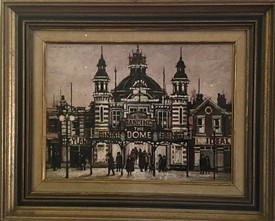
Dancing at the Dome (1970)
Newark Town Hall Museum Collection, kind permission of the artist's estate
By Dr Malcom Moyes
After their death most artists need a champion if their work is to endure beyond fleeting fashionable favour. Today’s flavour of the month all too often becomes tomorrow’s obscure footnote in a “Who’s Who?” of painting.
There are many ways of championing an artist of course, but probably the most effective one is the establishing of a permanent exhibition in a public space. The work is there to be seen, often freely, at most points in the year, stimulating interest and above all, giving visitors great pleasure. Such spaces are the very opposite of the private collection which by definition limits access to works of art and rarely seeks to champion a painter.
One such public space is the Newark Town Hall Museum, located on the second floor of the Town Hall, which has long championed the work of the Cleethorpes born artist Peter Brannan who, for over thirty years, had a close association with the town.
The driving force behind the promotion of Peter Brannan’s work at the Museum, since his death in 1994, has been Mrs Patty Temple and her team of excellent volunteers, themselves enthusiastic admirers of the paintings in their daily care. As well as creating a permanent exhibition of Peter Brannan’s work, the Museum has also organised two temporary exhibitions of his paintings at their Spotlight Gallery, one in 2010 titled Peter Brannan Retrospective and another three years later, in collaboration with the Goldmark Gallery in Uppingham, titled Peter Brannan: the Newark Years. Both of these exhibitions drew upon a small number of private collections to enable large numbers of people to enjoy paintings rarely seen in the public domain, at least on a short-term basis.
The permanent exhibition of Peter Brannan’s work itself has benefited from the unusual generosity of two private collectors: Mr Terry Trickett of Newark, a great benefactor of the Museum, who has both gifted and loaned paintings; and Mr and Mrs Dolby of Brant Broughton who have also loaned works to the Museum. These acts of public generosity form the core of the Town Hall Museum display and alongside the works owned by the Museum provide a welcome introduction to the painter and a flavour of the variety of his works, as well as some of his frequent artistic themes.
The earliest of the paintings in the collection, titled Grimsby Docks, is an oil on board and was completed in 1949. A favourite theme of many Lincolnshire painters, the picture shows dockers hard at work unloading cargo against a background of fishing boats and the landmark Dock Tower. Stylistically, probably because it is a very early piece, it is not typical of Brannan’s work, both in terms of composition and its representation of human activity; however, it is a useful starting point for the visitor to reflect upon the artist’s development as a painter.
Appropriately, there are paintings on exhibition with overt Newark connections. Newark Market Place, dated 1959, is an impressionistic view in predominantly brown and grey tones, and typical of many other paintings completed around the late 1950’s and early 1960’s. Mount Street School, completed in 1983, is one of several extant works depicting the place where Brannan first taught in the town, and again typically, he populates it with a variety of students standing outside the school building, whose attitudes to the impending school day seem markedly different.
Peter Brannan was primarily a painter of the East Coast, drawing especially on the imagery of the tourist landmarks of Cleethorpes, also much loved by the picture postcard industry. Two of the works in the Museum, purchased from the 2013 Spotlight Exhibition with the financial support of the Friends of the Museum, the Town Council and the Newark Area Arts and Leisure Foundation, are interesting examples of this aspect of Peter Brannan’s work. Wonderland and Dancing Nightly, both unsigned and undated, are impressionistic beach scenes, but they are significantly different, capturing two different moods of the town. Wonderland is more of an out-of-season composition with the sparsely populated beach occupied mainly by figures walking their dogs; they are dressed in warm coats and hats, and there is no activity in or around the background holiday amusements. Dancing Nightly, on the other hand, is a busy in-season beach scene with large numbers of families, in their swimwear and shorts, relaxing on the sand or in a deck chair. Above them is the predominantly white pier offering the seasonal attractions of the dance or playing bingo. The brightly painted pier links it with other structures in the scene, such as the white huts selling ice-creams and deck-chairs, whilst the Big Dipper remains oddly brown and gloomy, possibly suggesting that the painting is unfinished.
A third Cleethorpes-based scene, East Coast, completed in 1969, depicts the traditional seaside donkey and cart rides beneath the pier, popular with young children in the holiday season. The painting is on loan from Mr and Mrs Dolby and was given to them as a wedding present by the artist who, with typical apologetic modesty, did not think it was very good!
Along with Wonderland and Dancing Nightly, the Museum was also enabled to purchase Forty Winks, a charming, slightly comic little painting of the familiar middle-aged man, without a care in the world, fast asleep in a beach chair. He sleeps on, contentedly, next to an empty seat, presumably vacated by a wife, friend or partner, whilst life goes on busily around him. The piece is similarly unsigned and undated, but there are no architectural details to identify a specific coastal locality as its context.
Whilst commentators on Brannan’s output have rightly focussed upon his evocations of the East Coast and of Lincolnshire and Nottinghamshire townscapes, his work in the Still Life genre has received less attention. This is surprising as during his artistic life Brannan painted around forty Still Lifes, possibly more, some of which are exquisitely delicate in their recreation of inanimate objects. What is not surprising is that Brannan expressed great reverence for the great C18th French master of Still Lifes, Jean-Baptiste Simeon Chardin.
However, whilst Chardin’s paintings usually brought life to things of little intrinsic value, Brannan frequently painted small objects of desire from his personal collection of antiques, especially fine porcelain. These were often accompanied by flowers, especially Honesty, Chinese Lanterns and Daisies. The Town Hall Museum Collection has four Still Life paintings on view, painted between 1978 and 1988, all of which make use of pieces from the artist’s collection of ceramics.
Cups and Saucers is the earliest of the four and was shown in Peter Brannan’s One Man Exhibition at the Usher Gallery in 1978 (Number 44) bearing a Not for Sale label. The cups and saucers in question are in two piles next to each other on a bookshelf in an alcove; at the back of them is what appears to be a haphazard line of books topped by three other books, two of whose titles are visible: one of these is an Oxford English Dictionary and the other beneath is a work by the C19th French novelist Pierre Loti, probably The Marriage of Loti. The painting is painstakingly and lovingly detailed, especially the decoration on the C19th cups; at the same time, there is an interesting sense of the shabby chic in the whole composition, created by the distressed state of most of the books and by the staining on the white porcelain.
Still Life with Jug and Rocking Horse was completed a year later and has the number 37 on the verso of the painting, but as yet cannot be identified as an exhibition piece with any confidence. The jug, like the cups and saucers, has some signs of imperfection, alongside the attractive floral decoration on the rim and handle, and the sentimental motif on the side of the mother and young child. The different textures of the objects in the painting – the delicate jug, a more robust looking glazed pot containing paint brushes and the prancing horse – are convincingly realised.
Blue Jug with Honesty, completed in 1982, is one of several Still Lifes in which Brannan makes use of Honesty. More than the two works described above, it is a cluttered scene in which the blue jug containing the Honesty competes for our attention alongside Chinese Lanterns and Daisies strewn on the table between two bottles and on top of three porcelain bowls, paint brushes stood in the same glazed pot as Still Life with Jug and Rocking Horse, as well as a tantalising glimpse of rooftops in a painting, partially hidden by a large cup. And yet despite the apparent cluttered randomness of the arrangement, there is a fine sense of balance, tranquillity and harmony in the painting.
Victorian Jug, the latest in the collection, dated 1988, is an impressive painting of a C19th predominantly blue jug containing bunches of flowers, and is placed upon a patterned tablecloth. The jug has been arranged alongside other, mainly oriental artefacts, a collecting area of particular interest to Peter Brannan. The painting was exhibited in 1994 at the 88th Lincolnshire Artists’ Society Annual Exhibition, which sadly was Peter Brannan’s final public show whilst he was alive.
Perhaps the finest painting in the collection, and certainly the most intriguing, is Ariel View of a Town, completed in 1968, purchased in 1974 by the Newark Town Council, and immediately visible on first entering the Museum.
It is a bird’s-eye view of a town’s architecture and is dominated by roof tops in the foreground, and by the Tower Cinema, advertising bingo, in the middle right of the picture. To the left of the Tower Cinema are fragments of the town’s commercial life. The picture is bisected by a narrow street leading from the houses in the foreground to a distant shopping area. Like many of Brannan’s paintings of townscapes, there is an immediate sense of a definite locality created by the use of particular names, which in the final analysis, turn out to be inventions or an eclectic mix of real names and locations, assembled together in one imagined scene.
A Tower Cinema existed, and still exists, in Skegness, but the architecture has no resemblance to the image in the painting. The town layout with the narrow street leading to a larger street of shops, with a backdrop of a church spire, is reminiscent of Newark. Indeed, one of the names in the picture is that of Clews, a business which certainly existed in the 1960’s in Newark, listed as J Clews & Sons, house furnishers and upholsters, located at 10-11 Stodman Street. But the painting is undeniably a work of fiction, confirmed in a note by Peter Brannan himself, who records that the work started life as a painting demonstration at the Newark Technical College and is “an imaginary town”.
The same kind of eclecticism is evident in the smaller, but no less delightful loan painting titled Dancing at the Dome, dated 1970, and unusually, signed in the top left of the picture. The entertainment on offer at The Dome looks back towards the past, advertising Old Time Dancing, whilst also offering bingo, a popular fad at the time. As with Ariel View of a Town, there are tantalising fragments of local business names on view, albeit incomplete; although the word ideal in capital letters, to the right of the image of The Dome may be a recollection of Ideal Homes, doing business at 8 Appleton Gate around this time.
This brief excursion round the permanent Peter Brannan Exhibition does not include all the works on view – there are many other very interesting paintings and drawings to be seen. However, before concluding this introductory tour, one further painting should be mentioned. The Dentist, Lincoln, dated 1980, was exhibited in the late 1980’s at the Willoughby Memorial Hall in Corby Glen and was priced at £200. The painting was brought into the Newark Town Hall Museum many years later, having failed to sell at a jumble sale at St George’s Church, Swallowbeck, near Lincoln. The painting now rests securely and permanently on an easel in the Museum, a bizarre testament to the bewildering caprices of the world of art.
Malcolm Moyes